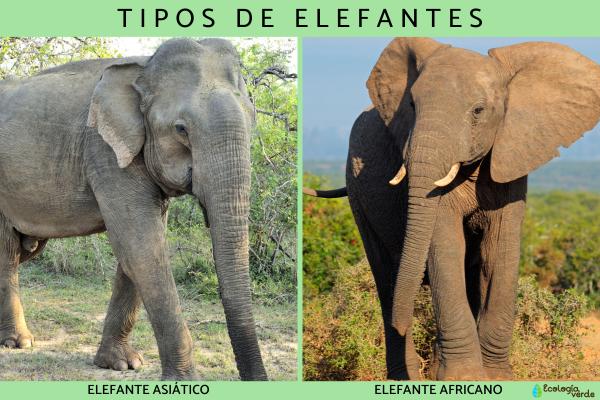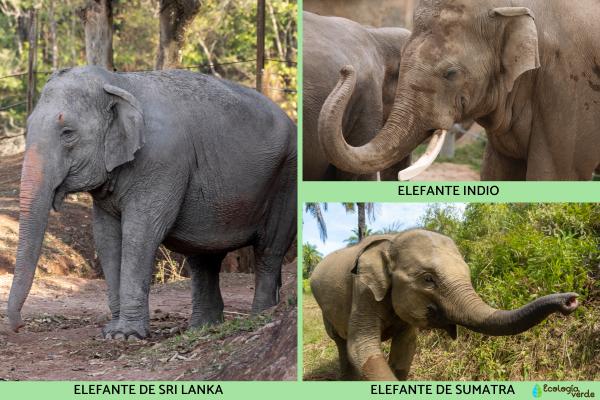There are five types of Elephants-Are-Endangered.html">elephants. The Asian elephant (Elephas maximus) is divided into three subspecies: the Sri Lankan elephant (Elephas maximus maximus), the Indian elephant (Elephas maximus indicus), and the Sumatran elephant (Elephas maximus sumatranus). There are two species of African Elephants-Are-Endangered.html">elephants: the African savanna elephant (Loxodonta africana) and the African forest elephant (Loxodonta cyclotis). Although other species of Elephants-Are-Endangered.html">elephants existed in the past, they are unfortunately now extinct.

Elephants are large mammals that are considered ecosystem engineers and seed dispersers in their environment. They are an umbrella species because their conservation also involves the conservation of other species that inhabit the same area. Although they are native to Asia and Africa, they are an emblematic species that have important cultural and symbolic significance around the world.
How Many Types of Elephants Exist?
Asian Elephants: Three Subspecies
African Elephants: Two Species
Extinct Elephant Species
Conclusion: Ecological Importance and Conservation
Modern elephants belong to the order Proboscidea and family Elephantidae, divided into two genera: Elephas (Asian elephants) and Loxodonta (African elephants). Today, there are five recognized types: three Asian elephant subspecies and two African elephant species. Many other elephant species are now extinct.
The Asian elephant is the only living species in its genus, found in Sri Lanka, India, Bangladesh, Southeast Asia, and parts of Borneo. They live in matriarchal herds in tropical forests, mainly eating leaves and fruits. Key differences from African elephants include smaller size, straighter ears, longer tails with black hair tufts, and not all individuals have tusks (elongated incisors, not canines).
Sri Lankan Elephant (Elephas maximus maximus)
The largest Asian subspecies, growing up to 3 meters tall and weighing up to 6 tons, mostly inhabiting the dry lowlands of Sri Lanka.
Indian Elephant (Elephas maximus indicus)
Slightly smaller, found across the Indian subcontinent (India, Nepal, Bangladesh, Bhutan), most males have tusks.
Sumatran Elephant (Elephas maximus sumatranus)
Critically endangered, living in the lowland rainforests of Sumatra, Indonesia. Females are generally smaller and tuskless. They play a vital role in seed dispersal for forest regeneration.
Asian elephants are classified as "Endangered" by the IUCN due to habitat fragmentation, poaching, and human conflict, requiring urgent conservation efforts.
There are two African elephant species:
African Savanna Elephant (Loxodonta africana)
The largest land animal, found in savannas, shrublands, grasslands, and open forests throughout Africa. Notable for their large, fan-shaped ears and forward-curved tusks. They are ecosystem engineers, maintaining biodiversity by shaping habitats. Poaching and habitat loss have led to their "Endangered" IUCN status.
African Forest Elephant (Loxodonta cyclotis)
Once considered a subspecies, now a separate species based on genetic studies. Smaller, with straighter downward tusks and rounder ears, they live in the dense rainforests of West and Central Africa. As frugivores, they help disperse seeds of large rainforest trees, crucial for carbon storage. Listed as "Critically Endangered" due to severe poaching and habitat loss.


Many elephant species have disappeared due to environmental change and human activity. Some examples: Loxodonta adaurora, Elephas antiquus, Elephas planifrons, Elephas namadicus, and more. Protecting today's elephants is vital for maintaining global biodiversity.
Elephants are not only the world's largest land mammals but also vital keystone species. Their survival ensures the health of entire ecosystems. Elephant conservation is crucial for the balance of nature. Public awareness and protective actions are essential to safeguard these magnificent animals for the future.
animal tags: Elephants
We created this article in conjunction with AI technology, then made sure it was fact-checked and edited by a Animals Top editor.